7. Where was what is probably a copy of the second edition of the Catena Aurea of Aquinas printed? The folio in question, which consists of 417 unnumbered leaves, is an extremely fine one, and I should say that it is certainly of German origin. Seemiller (i. 117.) refers it to Esslingen, and perhaps an acquaintance with its water-marks would afford some assistance in tracing it. Of these a rose is the most common, and a strigilis may be seen on folio 61. It would be difficult to persuade the proprietor of this volume that it is of so modern a date as 1474, the year in which what is generally called the second impression of this work appeared.
8. How can we best account for the mistake relative to the imaginary Bologna edition of Ptolemy’s Cosmography in 1462, a copy of which was in the Colbert library? (Leuglet du Fresnoy, Meth. pour etud. l’Hist., iii. 8., a Paris, 1735.) That it was published previously to the famous Mentz Bible of this date is altogether impossible; and was the figure 6 a misprint for 8? or should we attempt to subvert it into 9? The editio princeps of the Latin version by Angelus is in Roman letter, and is a very handsome specimen of Vicenza typography in 1475, when it was set forth “ab Hermano Leuilapide,” alias Hermann Lichtenstein.
9. If it be true, as Dr. Cotton remarks in his excellent Typographical Gazetteer, p. 22., that a press was erected at Augsburg, in the monastery of SS. Ulric and Afra, in the year 1472, and that Anthony Sorg is believed to have been the printer, why should we be induced to assent to the validity of Panzer’s supposition that Nider’s Formicarius did not make its appearance there until 1480? It would seem to be more than doubtful that Cologne can boast of having produced the first edition, A.D. 1475/7; and it may be reasonably asserted, and an examination of the book will abundantly strengthen the idea, that the earliest impression is that which contains this colophon, in which I would dwell upon the word “editionem” (well known to the initiated): “Explicit quintus ac totus formicarii liber uxta editionem fratris Iohannis Nider,” &c., “Impressum Auguste per Anthonium Sorg.”
10. In what place and year was Wilhelmi Summa Viciorum first printed? Fabricius and Cave are certainly mistaken when they say Colon. 1479. In the volume, which I maintain to be of greater antiquity, the letters c and t, s and t, are curiously united, and the commencement of it is: “Incipit summa viciorum seu tractatus moral’ edita [sic] a fratre vilhelmo episcopo lugdunes. ordinsq. fratru predicator.” The description given by Quetif and Echard (i. 132.) of the primary impression of Perault’s book only makes a bibliomaniac more anxious for information about it: “in Inc. typ. absque loco anno et nomine typographi, sine numeris reclamat. et majusculis.”
11. Was Panormitan’s Lectura super primo Decretalium indubitably issued at Venice, prior to the 1st of April, 1473? and if so, does it contain in the colophon these lines by Zovenzonius, which I transcribe from a noble copy bearing this date?




